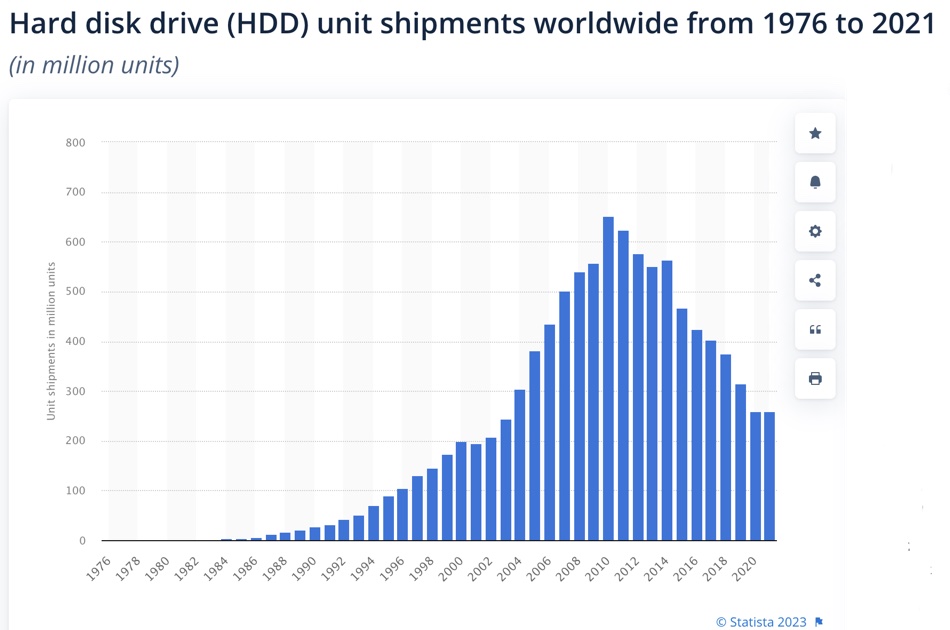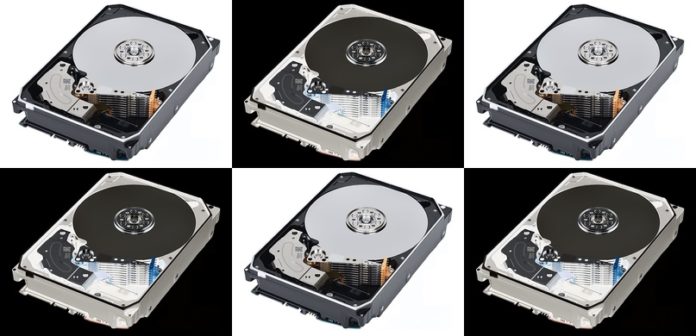A Toshiba exec has argued that hard disk drives are essential to store data in several market areas because SSDs are ill-suited to the job, costing more and with limited manufacturing capacity.
Update. Question answers re the SNIA’s Emerald initiative and energy efficiency added; 24 January 2023.

Citing TrendFocus numbers, Toshiba Electronics Europe exec Rainer Kaese said: “259 million HDDs were shipped last year – a case in point. Their total capacity reached 1.338 zettabytes, an increase of almost one-third compared to 2020. Never before have HDDs been shipped with more combined storage capacity.”
That is so but the unit shipment numbers are flat. Statista says 258.9 million units were shipped in 2021, which was 2 percent less than 2020’s 260.3 million units. Back in 2010, there were 650 million disk drives shipped. The numbers have declined due to replacement by SSDs and because disk capacity on nearline (7.2K rpm, 3.5-inch drives) has ramped higher and higher, in Toshiba’s case at the 20TB level.

SSD replacement momentum has stalled as SSD $/TB price falls have slowed and are more or less parallel with HDD $/TB declines.
Writing in Global Security Mag, Kaese claimed: “SSDs are not expected to completely replace hard disks at any point. Since the need for storage space is growing virtually everywhere and only HDDs can deliver the high storage capacities at low costs that datacenters, cloud and other application areas demand, both media will continue to coexist for years to come.”
Kaese said market sectors where HDDs excel over SSDs start with online storage in core and cloud datacenters. He declared: “HDDs are simply the most economical medium for these large online storage facilities; their capacity is constantly increasing due to the advancement of technology, while the price per Terabyte is continuously decreasing. Flash memory is much more expensive and could not be produced in sufficient quantities, so it is mainly used as a cache when the data throughput of hard disk arrays is insufficient.”
The second sector he alights on is: “Network storage in companies and households: network-attached storage (NAS) systems serve as central data storage and backup storage for many small and medium-sized companies, but also in more and more households.”
That’s because “they can comfortably handle the transfer speeds in most company and home networks, where the high performance of flash memory would only be noticeable when transferring very many small files. In this case a caching SSD, for which some NAS systems have a separate slot, is sufficient.”
A third market sector is: “Video surveillance: The market for video surveillance is booming because people’s need for security is growing, and the systems are becoming cheaper and cheaper, making them affordable for private users.”
Next we have: “External storage for computer users and gamers: Flash memory has displaced the hard disk from almost all client systems, but because the manufacturers of PCs, notebooks and games consoles often only install quite small SSDs for cost reasons, users today generally have less storage capacity available in the devices than in the hard disk era.”
The problem is solved by adding external storage: “Usually data will be stored externally in ‘the cloud’, but people may prefer to have access to locally situated storage – due to cost reasons or security concerns. External hard disks with 2 or 4 terabyte are therefore extremely popular, and are a simple and inexpensive way for many users to expand their storage.”
His fifth sector is archiving: “When it comes to long-term storage of data, hard disks are the storage medium of choice, along with tapes. HDDs are somewhat more expensive for the same capacity, but they score points for shorter access times when certain documents need to be retrieved for an audit. In addition, HDDs can use deduplication mechanisms to reduce the amount of data to be archived, which can significantly reduce costs, depending on the type of data.”
Deduplicated data can be stored on tape, clawing back that HDD advantage. Absent that point, Kaese is effectively saying one should use HDD-based archives for “certain documents” that need shorter access times when an audit is being run. That suggests the audit comes around in an unexpectedly short time as, with more notice, a tape-based archive with a disk front-end cache could serve up the documents.
Blocks & Files thinks that HDD unit ship numbers will continue to decline, due to SSD cannibalization, and that the HDD manufacturers need MAMR, HAMR and SMR technologies to continue enjoying their $/TB advantage over SSDs. That’s because SSD suppliers can keep on adding more layers to their chips, currently around the 176-layer level, and so reduce their own $/TB cost.
Update
We asked Rainer Kaese a couple of questions questions and here are the answers;
Blocks & Files: Does Toshiba support the SNIA’s Emerald initiative?
Rainer Kaese: So, we are referring to tests performed in the HDD applications lab in Europe for different JBOD solutions featuring Toshiba drives. Toshiba’s R&D is contributing to SNIA’s Emerald initiative, but the evaluations conducted at our European HDD applications lab are done in ways that have lower levels of complexity (not to SNIA Emerald standards).
The sentence “… roadmaps stipulate” is in reference to the ‘typical’ data explosion figures (published by industry analysts like IDC) and also the energy efficiency targets that data center operators have set. Based on these, lower power per capacity is required if the total storage installed is going to keep up with demands. Toshiba is making a significant contribution here by introducing high-capacity helium-filled HDDs. See page 5 of the attached material presented at Cloudfest 2022. It should also be noted that there are ways of attaining greater power savings at a system level by using all existing power/idle/standby features of the HDD, but this has to be implemented from the host/system side.
Blocks & Files: Energy efficient compared to what? 10K drives? Wouldn’t QLC NAND be more energy-efficient still?
Rainer Kaese: Here we mean compared to conventional 7200 RPM air-filled HDDs of 10TB capacities and lower. Basically there are 3 ways for storing data in video surveillance.
These are:
- 5×00 RPM drives using SMR technology. These are more desktop type class for low-end recording with just one drive. They are energy and cost-efficient, allowing basic review functions but almost no specific analytics.
- Using higher capacity CMR 7200 RPM surveillance drives (6TB to 10TB). Allows multi-drive/RAID and analytics, but are relatively power hungry (due to rather low capacity per drive, and use of air-filled drive cavities).
- Using 7200rpm CMR helium-filled drives (14TB capacity and above). This approach provides elevated analytical capabilities and lower power per capacity.
10k RPM drives are not a practical option in a surveillance context, due to having too low capacity and requiring too high a power budget. Nor is QLC-NAND. It may be more energy efficient, but still has far too high a cost per capacity. Also the endurance limitations do not match well with the workload characteristics of this application – where overwriting again and again is needed.







